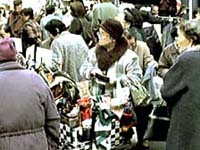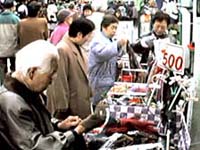
A begging bonze
|
Even in a modern and international metropolis like Tokyo, there are areas which preserve local tradition, culture and history. Those places in Tokyo are mostly located in the north and the east.
Asakusa and
Ueno are famous and you might have heard of those names. Sumo tournament takes place in
Ryogoku.
Such areas are called "
shitamachi". The English translation of shitamachi is "
downtown". However, the two words have different nuances, I think.
The word "shitamachi" does not simply mean an area where many shops, restaurants and other urban facilities are concentrated.
Shitamachi is a home-ground of small merchants and artisans whose families have traditionally lived there. Therefore it forms different characteristics from the modern city centers and residential areas where the majority are big companies and their employees and families.
Shitamachi retains a nostalgic atmosphere as it has failed to catch up with the modernization of Tokyo. In another words, there is a stagnation. But, exactly because of this, we can enjoy not only the old atmosphere but also low prices for all goods and services in shitamachi.

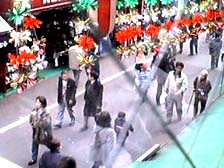 | 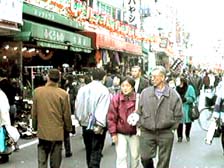 |
| Jizo street shopping area |
Sugamo was historically a village outside of Edo city and is not a part of shitamachi in its original sense. However, it well retains the very atmosphere of shitamachi. Near from Sugamo JR station there is Koganji Temple. The temple, however, is famous as "
Togenuki Jizo"
*
* "Toge-nuki" means "pick a thorn out". "Jizo" is in Sanskrit Ksitigarbha; guardian deity of children. "Togenuki Jizo" is believed to remove the cause of all kinds of illness.
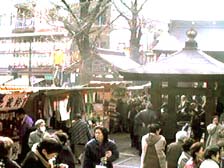
The courtyard of Toganji Temple
Togenuki Jizo is new in this area. It moved from Sitaya, near Ueno, during the Meiji era, i.e. at the end of 19th century. The chief priest then invited stalls to the courtyard of the temple and more and more stalls came in so that the whole approach became a busy shopping street.
I finally reached the topic, Sugamo "Jizo street shopping area", which is a very particular place in Tokyo. The people gathering here are mostly old and middle-aged women. They are really very energetic and look pleasant and cheerful as the young girls in Harajuku or Shibuya.
Especially in the days of 4, 14 and 24 of each month, a special market is held in front of "Togenuki Jizo" and tens of thousands of grandmas gather from Tokyo and the neighbouring prefectures. So, "Jizo street shopping area" is called "Grandmas' Harajuku"
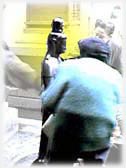
Kwannon |
In the court of Togenuki Jizo, a small statue of
Kwannon-Bosatsu stands and hundreds of people are queuing to pour water on the statue and clean it with a towel. The illness in the part of the Kwannon statue you wash , it is believed, will be cured by doing this. This Kwannon is popular, especially because
it is believed to fulfill the wish of prayers to die without bothering their relatives for their care. So, the grandmas will die peacefully and they don't have to be taken care by the daughters-in-law.
The bustle of this area is in reality the result of this modest wish of the old women.
Grandmas are energetic !!!
When they have finished the service, grandmas go shopping and dining in groups. There are many shops which are adapted to the needs and tastes of grandmas. Clothes are specially prepared for the need of old women and there are many other goods available which are familiar to them.
There are no French bistros nor Italian pizzeria, but traditional Japanese restaurants including a famous lamprey (Eel-like strange fish, which looks to have 8 "eyes" one one side of the body. ) restaurant.
No Western style cakes are available, but there are "
Daifuku" and other traditional sweets, pickles, rice cakes, green tea and all other favourites of grandmas.
After the pleasure they go home with big plastic bags full of souvenirs. Grandmas are much healthier and much more genius in enjoying life than young businessmen!





